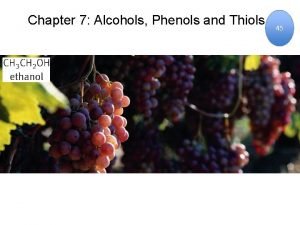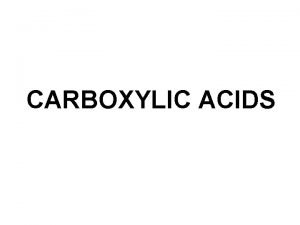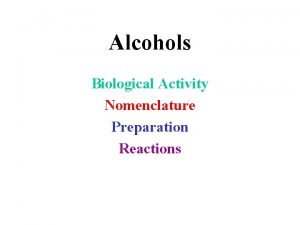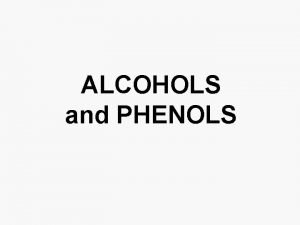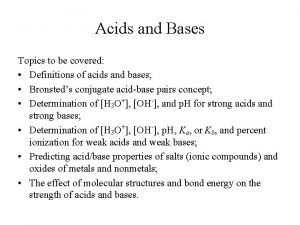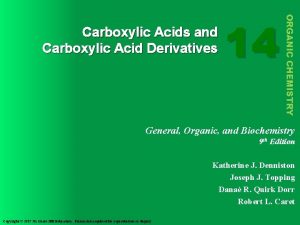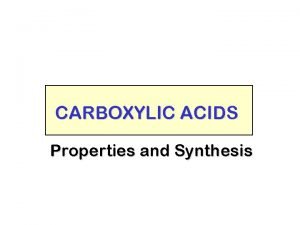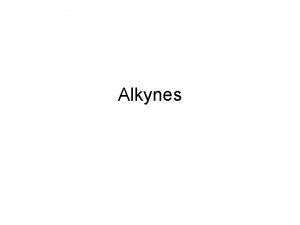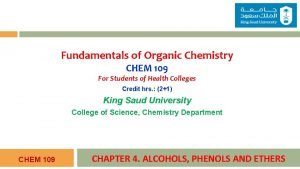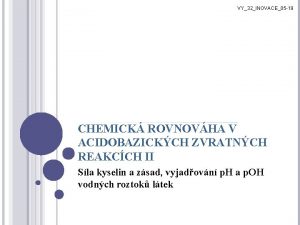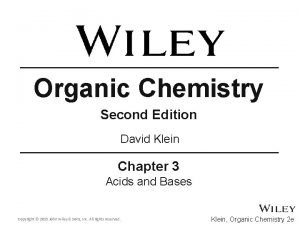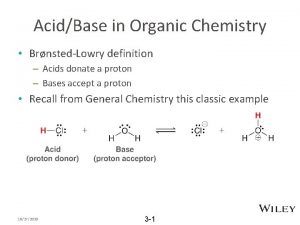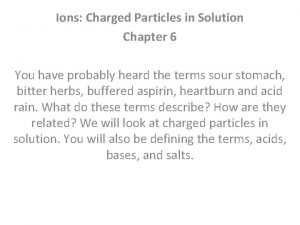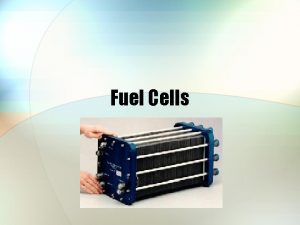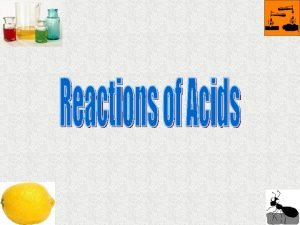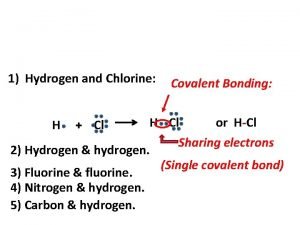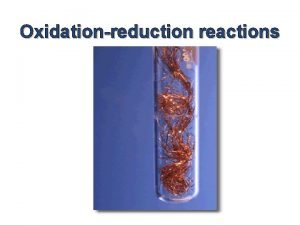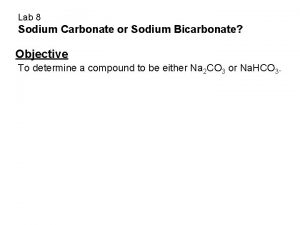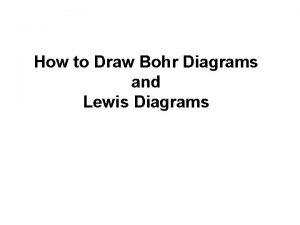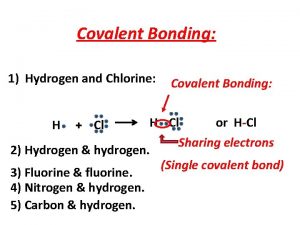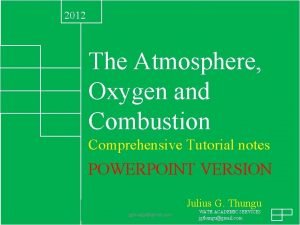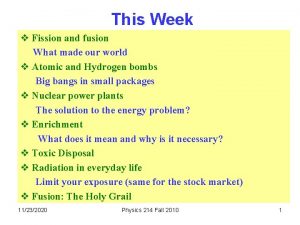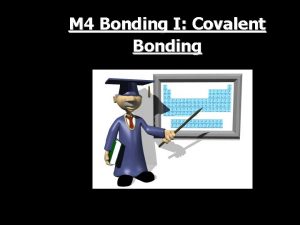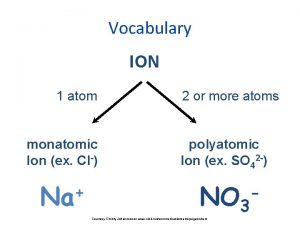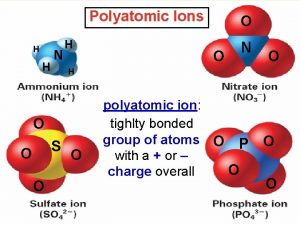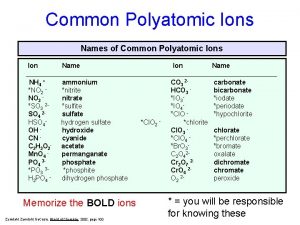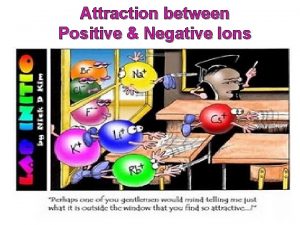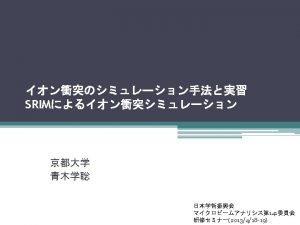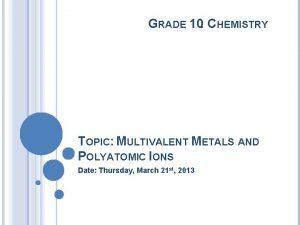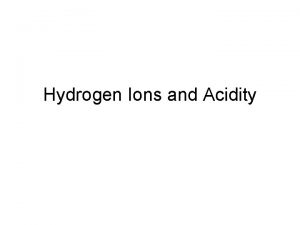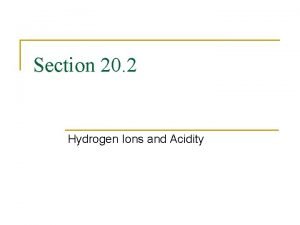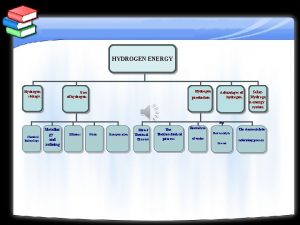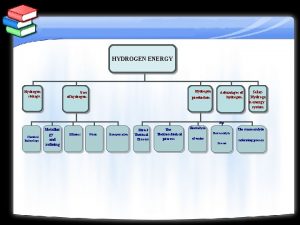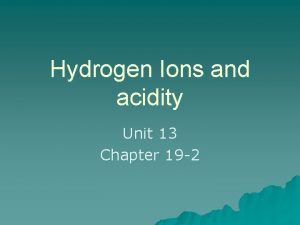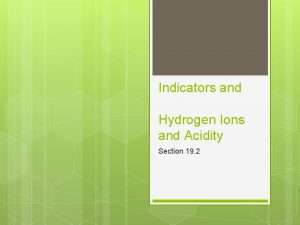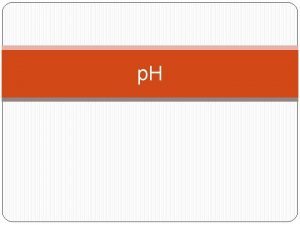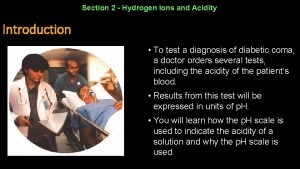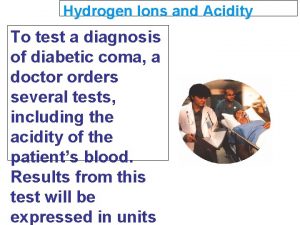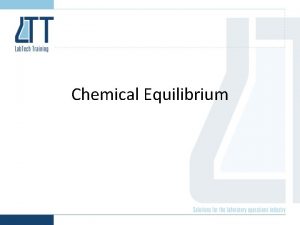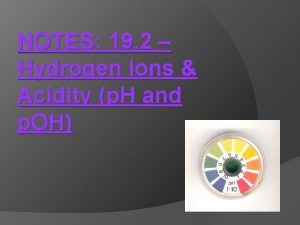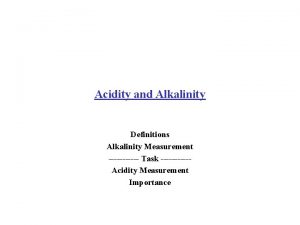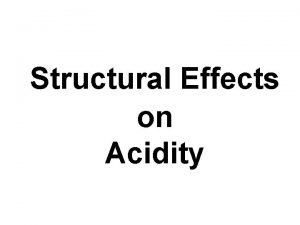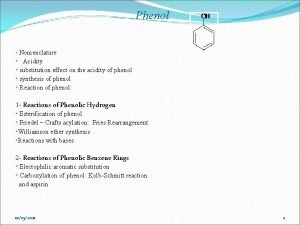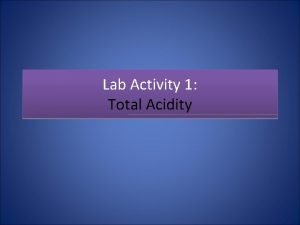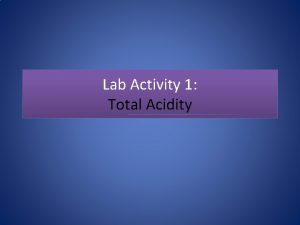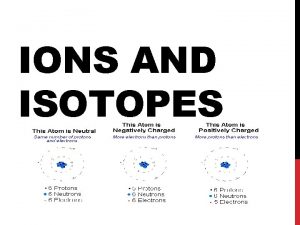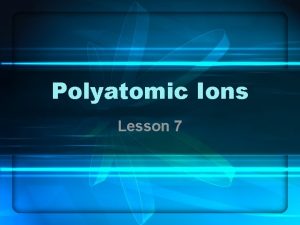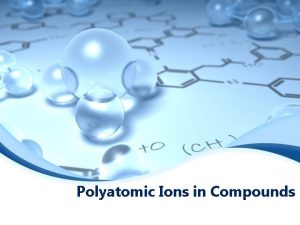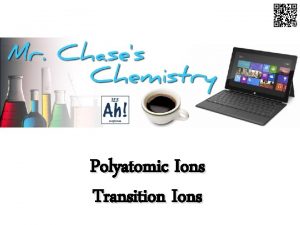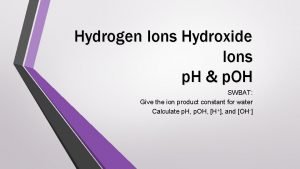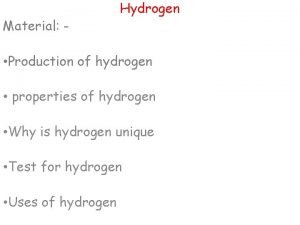Hydrogen Ions and Acidity PrenticeHall Chapter 19 2

![Objectives v Describe how [H+] and [OH-] are related in an aqueous solution v Objectives v Describe how [H+] and [OH-] are related in an aqueous solution v](https://slidetodoc.com/presentation_image_h2/39a4187a5b18eccdb1c35045c760f287/image-2.jpg)






![Acidic Solution An acidic solution is one in which [H+] is greater than [OH-]. Acidic Solution An acidic solution is one in which [H+] is greater than [OH-].](https://slidetodoc.com/presentation_image_h2/39a4187a5b18eccdb1c35045c760f287/image-9.jpg)

![Basic Solution A basic solution is one in which [H+] is less than [OH Basic Solution A basic solution is one in which [H+] is less than [OH](https://slidetodoc.com/presentation_image_h2/39a4187a5b18eccdb1c35045c760f287/image-11.jpg)







![Calculating Neutral p. H A solution in which [H+] is greater than 1 10 Calculating Neutral p. H A solution in which [H+] is greater than 1 10](https://slidetodoc.com/presentation_image_h2/39a4187a5b18eccdb1c35045c760f287/image-19.jpg)
![p. H and [H+] p. H and [H+]](https://slidetodoc.com/presentation_image_h2/39a4187a5b18eccdb1c35045c760f287/image-20.jpg)
















![1. If the [OH-] in a solution is 7. 65 10 -3 M, what 1. If the [OH-] in a solution is 7. 65 10 -3 M, what](https://slidetodoc.com/presentation_image_h2/39a4187a5b18eccdb1c35045c760f287/image-37.jpg)
![1. If the [OH-] in a solution is 7. 65 10 -3 M, what 1. If the [OH-] in a solution is 7. 65 10 -3 M, what](https://slidetodoc.com/presentation_image_h2/39a4187a5b18eccdb1c35045c760f287/image-38.jpg)
![2. The [OH-] for four solutions is given below. Which one of the solutions 2. The [OH-] for four solutions is given below. Which one of the solutions](https://slidetodoc.com/presentation_image_h2/39a4187a5b18eccdb1c35045c760f287/image-39.jpg)
![2. The [OH-] for four solutions is given below. Which one of the solutions 2. The [OH-] for four solutions is given below. Which one of the solutions](https://slidetodoc.com/presentation_image_h2/39a4187a5b18eccdb1c35045c760f287/image-40.jpg)


- Slides: 42

Hydrogen Ions and Acidity Prentice-Hall Chapter 19. 2 Dr. Yager
![Objectives v Describe how H and OH are related in an aqueous solution v Objectives v Describe how [H+] and [OH-] are related in an aqueous solution v](https://slidetodoc.com/presentation_image_h2/39a4187a5b18eccdb1c35045c760f287/image-2.jpg)
Objectives v Describe how [H+] and [OH-] are related in an aqueous solution v Classify a solution as neutral, acidic, or basic given the hydrogen-ion or hydroxide-ion concentration v Convert hydrogen-ion concentration into p. H values and hydroxide-ion concentrations into p. OH values v Describe the purpose of an acid-base indicator

To test a diagnosis of diabetic coma, a doctor tests for the acidity of the patient’s blood. Results from this test will be expressed in units of p. H. You will learn how the p. H scale is used to indicate the acidity of a solution.

Self-Ionization of Water The reaction in which water molecules produce ions is called the self-ionization of water.

In the self-ionization of water, a proton (hydrogen ion) transfers from one water molecule to another water molecule.

The self-ionization of water is a reversible reaction. The concentrations of hydronium and hydroxide ions are equal and known, that is: [H 3 O+] = [OH-] = 1 x 10 -7 M In any aqueous solution when [H 3 O+] and [OH-] are equal the solution is neutral.

Ion Constant Product for Water Calculate the equilibrium constant for the reaction of self-ionization of water: H 2 O (l) + H 2 O (l) H 3 O+(aq) + OH-(aq) [H 3 O+] [OH-] = (1. 0 x 10 -7) = 1. 0 10 -14 or Kw = 1. 0 10 -14.

The product of the concentrations of hydrogen ions and hydroxide ions in water is called the ion-product constant for water (Kw).
![Acidic Solution An acidic solution is one in which H is greater than OH Acidic Solution An acidic solution is one in which [H+] is greater than [OH-].](https://slidetodoc.com/presentation_image_h2/39a4187a5b18eccdb1c35045c760f287/image-9.jpg)
Acidic Solution An acidic solution is one in which [H+] is greater than [OH-].

Unrefined hydrochloric acid, commonly called muriatic acid, is used to clean stone buildings and swimming pools.
![Basic Solution A basic solution is one in which H is less than OH Basic Solution A basic solution is one in which [H+] is less than [OH](https://slidetodoc.com/presentation_image_h2/39a4187a5b18eccdb1c35045c760f287/image-11.jpg)
Basic Solution A basic solution is one in which [H+] is less than [OH ]. Basic solutions are also known as alkaline solutions.

Sodium hydroxide, or lye, is commonly used as a drain cleaner.





The p. H Concept What does p. H stand for? p. OWER of Hydrogen

The p. H Concept The p. H of a solution is the negative logarithm of the hydrogen-ion concentration.
![Calculating Neutral p H A solution in which H is greater than 1 10 Calculating Neutral p. H A solution in which [H+] is greater than 1 10](https://slidetodoc.com/presentation_image_h2/39a4187a5b18eccdb1c35045c760f287/image-19.jpg)
Calculating Neutral p. H A solution in which [H+] is greater than 1 10 -7 M has a p. H less than 7. 0 and is acidic. The p. H of pure water or a neutral aqueous solution is 7. 0. A solution with a p. H greater than 7 is basic and has a [H+] of less than 1 10 -7 M.
![p H and H p. H and [H+]](https://slidetodoc.com/presentation_image_h2/39a4187a5b18eccdb1c35045c760f287/image-20.jpg)
p. H and [H+]



Calculating p. OH










Measuring p. H An indicator is a valuable tool for measuring p. H because its acid form and base form have different colors in solution. Phenolphthalein changes from colorless to pink at p. H 8– 9.

Acid-Base Indicators


Universal Indicators
![1 If the OH in a solution is 7 65 10 3 M what 1. If the [OH-] in a solution is 7. 65 10 -3 M, what](https://slidetodoc.com/presentation_image_h2/39a4187a5b18eccdb1c35045c760f287/image-37.jpg)
1. If the [OH-] in a solution is 7. 65 10 -3 M, what is the [H+] of this solution? a) 7. 65 10 -17 M b) 1. 31 10 -12 M c) 2. 12 M d) 11. 88 M
![1 If the OH in a solution is 7 65 10 3 M what 1. If the [OH-] in a solution is 7. 65 10 -3 M, what](https://slidetodoc.com/presentation_image_h2/39a4187a5b18eccdb1c35045c760f287/image-38.jpg)
1. If the [OH-] in a solution is 7. 65 10 -3 M, what is the [H+] of this solution? a) 7. 65 10 -17 M b) 1. 31 10 -12 M c) 2. 12 M d) 11. 88 M
![2 The OH for four solutions is given below Which one of the solutions 2. The [OH-] for four solutions is given below. Which one of the solutions](https://slidetodoc.com/presentation_image_h2/39a4187a5b18eccdb1c35045c760f287/image-39.jpg)
2. The [OH-] for four solutions is given below. Which one of the solutions is basic? a) 1. 0 x 10 -6 M b) 1. 0 x 10 -8 M c) 1. 0 x 10 -7 M d) 1. 0 x 10 -14 M
![2 The OH for four solutions is given below Which one of the solutions 2. The [OH-] for four solutions is given below. Which one of the solutions](https://slidetodoc.com/presentation_image_h2/39a4187a5b18eccdb1c35045c760f287/image-40.jpg)
2. The [OH-] for four solutions is given below. Which one of the solutions is basic? a) 1. 0 x 10 -6 M b) 1. 0 x 10 -8 M c) 1. 0 x 10 -7 M d) 1. 0 x 10 -14 M

3. What is the p. H of a solution with a hydrogen-ion concentration of 8. 5 x 10 -2 M? a) 12. 93 b) 8. 50 c) 5. 50 d) 1. 07

3. What is the p. H of a solution with a hydrogen-ion concentration of 8. 5 x 10 -2 M? a) 12. 93 b) 8. 50 c) 5. 50 d) 1. 07
 What do the roman numerals in a cation's name indicate
What do the roman numerals in a cation's name indicate Soil structure ppt
Soil structure ppt Thiol molecules
Thiol molecules Carboxylic acid to ester
Carboxylic acid to ester Reduction of alcohol to alkane
Reduction of alcohol to alkane Sp
Sp Acid base trends
Acid base trends Acidity of thiols
Acidity of thiols Carboxylic acid + base
Carboxylic acid + base Difference between metal oxides and non metal oxides
Difference between metal oxides and non metal oxides Carboxylic acid + amine
Carboxylic acid + amine Acidity hybridization
Acidity hybridization Grignard reagent formula
Grignard reagent formula Iontový součin vody
Iontový součin vody Ario acidity
Ario acidity Ario acidity
Ario acidity Chapter 2 atoms molecules and ions
Chapter 2 atoms molecules and ions Chapter 13 ions in aqueous solutions
Chapter 13 ions in aqueous solutions Ions charged particles in solution
Ions charged particles in solution Alkaline fuel cell animation
Alkaline fuel cell animation Experimental study of hydrogen release and ignition from
Experimental study of hydrogen release and ignition from Acid+metal=salt+hydrogen examples
Acid+metal=salt+hydrogen examples Hydrogen bond and covalent bond
Hydrogen bond and covalent bond Copper oxide + magnesium
Copper oxide + magnesium Na2co3 + hcl
Na2co3 + hcl Lithium lewis dot structure
Lithium lewis dot structure Covalent bond hydrogen and chlorine
Covalent bond hydrogen and chlorine Laboratory preparation of oxygen
Laboratory preparation of oxygen I intro
I intro Difference between atomic bomb and hydrogen bomb
Difference between atomic bomb and hydrogen bomb Bonding
Bonding Cl
Cl Polyatomic ions
Polyatomic ions Charges of compounds
Charges of compounds 89. common polyatomic ions
89. common polyatomic ions Electrostatic attraction between positive and negative ions
Electrostatic attraction between positive and negative ions Srim the stopping and range of ions in matter
Srim the stopping and range of ions in matter What are multivalent metals
What are multivalent metals Freezing point chapter 13
Freezing point chapter 13 Ion chapter 11
Ion chapter 11 Atoms molecules and ions
Atoms molecules and ions Atoms molecules and ions
Atoms molecules and ions Atoms molecules and ions
Atoms molecules and ions


